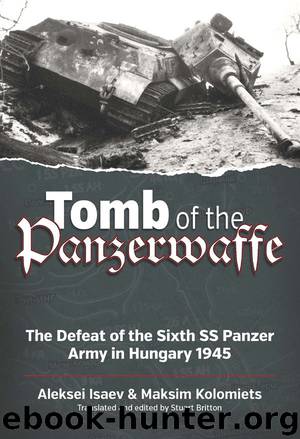Tomb of the Panzerwaffe: The Defeat of the Sixth SS Panzer Army in Hungary 1945 by Aleksei Isaev & Maksim Kolomiets

Author:Aleksei Isaev & Maksim Kolomiets [Isaev, Aleksei]
Language: eng
Format: epub, azw3
Tags: HISTORY / Military / World War II
ISBN: 9781912174690
Publisher: Helion and Company
Published: 2014-07-18T22:00:00+00:00
7
Results and Conclusions
The January German offensive with the aim of freeing the Budapest garrison through the introduction of several fresh divisions, including panzer divisions, into the fighting can be called an attempt to reach an objective with far too inadequate forces. From the point of view of tank operations, the optimal route of attack around Lake Velence from the south required significant reserves in order to cover the extending flanks. However, this was no longer 1940, 1941 or even 1942. Thus the German command no longer had army corps with powerful infantry divisions. The panzer divisions of Gille’s panzer corps simultaneously had to crack the Soviet defenses and to tend to threats to its flanks. All of this slowed the advance and allowed the Soviet command to set up a new line of defense.
Given all the ambiguities of such an indicator as casualties, they are still the yardstick for assessing many battles. The currently available data don’t in any way permit the success of the Soviet forces in repelling the Konrad offensives to be called a pyrrhic victory. The personnel losses of the 4th Guards Army for January 1945 amounted to 3,588 killed, 11,552 wounded, 4,543 missing in action, 132 non-combat injuries, and 1,682 sick.1 In total, G.F. Zakharov’s army, which carried the main burden of repelling the German offensives, lost 21,467 men. According to the measures of 1945, these casualties are rather high, especially with respect to the missing in action. The overall losses of the 5th Guards Cavalry Corps, which was subordinate to the 3rd Ukrainian Front for January 1945, amounted to 2,165 men. The Front’s 18th Tank Corps suffered 1,740 casualties, and the 23rd Tank Corps, in the course of the counteroffensive between 26 and 31 January lost 313 killed and 659 wounded.
The losses of Armeegruppe Balck for January 1945 (excluding those of the IX SS Gebirgs Corps in Budapest) amounted to 3,598 killed, 16,504 wounded, 1,520 missing in action and 12,751 sick.2 The causes for the high number of sick are unknown; possibly, the lightly wounded were included in this category. It also isn’t clear whether these figures include the Hungarian losses, but most likely they do not. Altogether, the losses of Armeegruppe Balck can be placed at 25-30,000 men.
The overall balance of losses between Armeegruppe Balck on the one hand, and the opposing armies of the 2nd and 3rd Ukrainian Fronts on the other, gives a doubtless advantage to the Soviet side, especially when the complete destruction and imprisonment of the Budapest garrison is considered. The losses of the troops that were assaulting the Hungarian capital were substantially lower than those of its garrison. For example, the total losses of the assaulting 18th Guards Rifle Corps for January 1945 was 2,357 men, and of the 7th Guards Army – 9,120 men (including combat operations outside of Budapest).
The 18th Tank Corps, which became the bulwark of the 3rd Ukrainian Front’s defense, over the month of January 1945, lost 161 T-34, 21 ISU-122, 21 SU-76, 13 ISU-152, and 12 SU-85.
Download
Tomb of the Panzerwaffe: The Defeat of the Sixth SS Panzer Army in Hungary 1945 by Aleksei Isaev & Maksim Kolomiets.azw3
This site does not store any files on its server. We only index and link to content provided by other sites. Please contact the content providers to delete copyright contents if any and email us, we'll remove relevant links or contents immediately.
| Africa | Americas |
| Arctic & Antarctica | Asia |
| Australia & Oceania | Europe |
| Middle East | Russia |
| United States | World |
| Ancient Civilizations | Military |
| Historical Study & Educational Resources |
The Radium Girls by Kate Moore(10907)
The Templars by Dan Jones(4188)
100 Deadly Skills by Clint Emerson(4076)
Rise and Kill First by Ronen Bergman(4012)
The Doomsday Machine by Daniel Ellsberg(3730)
The Rape of Nanking by Iris Chang(3516)
Killing England by Bill O'Reilly(3455)
Hitler in Los Angeles by Steven J. Ross(3435)
Stalin by Stephen Kotkin(3084)
12 Strong by Doug Stanton(3057)
Hitler's Monsters by Eric Kurlander(2731)
Darkest Hour by Anthony McCarten(2645)
Blood and Sand by Alex Von Tunzelmann(2608)
The Art of War Visualized by Jessica Hagy(2412)
Hitler's Flying Saucers: A Guide to German Flying Discs of the Second World War by Stevens Henry(2293)
The Code Book by Simon Singh(2209)
The Second World Wars by Victor Davis Hanson(2134)
Babylon's Ark by Lawrence Anthony(2070)
Tobruk by Peter Fitzsimons(2060)
